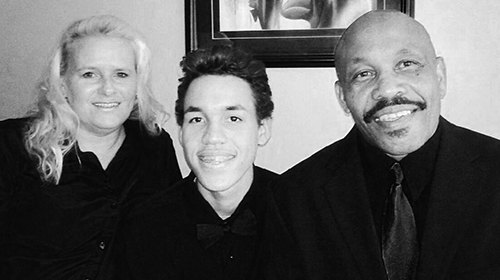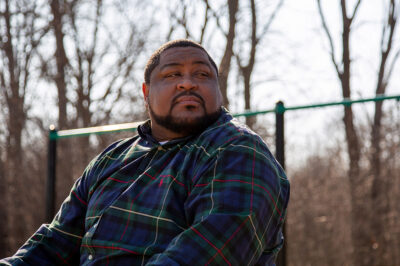
Kaleb Winston loved to draw. A sketchpad never far from reach, he drew constantly, hoping one day to be an architect like his grandfather.
That was before the gang sweep.
In December 2010, two plainclothes police officers approached Kaleb in the cafeteria at Salt Lake City’s West High School and said, “Come on. We’re going to make you look cool.” The honor roll student, who his mother Lisa says has “never been in trouble a day in his life,” thought perhaps he was being recognized for his hard work and good grades.
Instead, he found himself held in the school’s detention room and accused of being a gang banger. As evidence, the officers pointed to his backpack with the sketchpad in it.
The backpack, an early Christmas present from his parents for getting an “A” on a test, was emblazoned with graffiti-style writing, reflective of his interest in skateboarding. The sketches were homework assignments from art class.
Although Kaleb protested that he was no gang member, the officers alleged that his backpack and sketches proved otherwise. They called him a liar, saying a teacher tipped them off that he had been spraying Maze graffiti around the school.
The interrogation lasted 45 minutes, with Kaleb repeatedly asking to call his mother. His requests were denied. All told, he was detained by police for an hour and a half.

Before he was released, the 14-year-old freshman was made to pose for a photo in which he held up a sign reading, “My name is Kaleb Winston and I am a gang tagger.” The photo would be entered into a Salt Lake City Police Department gang database, subjecting Kaleb to further scrutiny from local law enforcement despite his never having committed a crime.
When he finally was allowed to go home, Kaleb was so upset he could barely speak. All he said to his mother was, “I’m tired of being Black.”
Since that day, Kaleb has completely stopped drawing. He no longer dreams of being an architect.
“A Problem with Mexicans”
Talking about the incident more than three years later, the Winstons’ outrage is still fresh.
“When I questioned the police about why they interrogated Kaleb, they said, ‘He looks the type,'” says Lisa, who demanded to know what “type” they meant. An officer replied that they had “a problem with Mexicans.”
Lisa is white. Her husband, Kevin, is Black. Yet to the police officers who accused him of being a gang tagger, their son’s light brown skin was sufficient cause to include him in their sweep.
“When I got there, they didn’t even make the connection between me and Kaleb,” Lisa remembers. “They insisted he wasn’t part of the sweep — until Kaleb came into the room and they realized that the kid they assumed was Mexican had a white mom.”
She further notes that it shouldn’t matter what color or ethnicity her son might be. “They said, ‘Oh, we thought he was Mexican’ — like that makes a difference. It doesn’t.”

According to an ACLU class-action lawsuit filed on behalf of Kevin and a class of Salt Lake City public school students, the gang sweep that ensnared Kaleb rounded up between 14 and 40 students. They are all Latino, African-American, or Pacific Islander students in a school where those populations make up only half of the student body. Like Kaleb, they were “detained, interrogated, searched and forced to be photographed holding signs identifying them as gang members.” The ACLU complaint states that the school had no legal justification for calling the police unit to perform the sweep.
“That’s why we wanted to file a class-action suit,” Kevin explains. “It wasn’t just about Kaleb. Nobody’s child should be hauled into a room and interrogated by the police just because of their skin color.”
Apart from the mental and emotional distress he experienced, Kaleb also came home with bruises from being grabbed by the arm when he tried to leave the interrogation room. That was followed by isolation in a police substation within the school, with further questioning.
Piling insult onto that injury, a police officer dismissed Lisa’s explanation that Kaleb’s sketchpad had been provided by his art teacher, and that the sketches were graded homework assignments, by snarling abusive profanities.
“And they thought I was mad before that!” she exclaims.
“They thought they were picking on a Hispanic kid they could put into their system, and we wouldn’t say anything about it. And they were totally wrong,” says Kevin, adding that he and Lisa have no compunctions about continuing to challenge the school district’s policies. “They know we’re not going to put up with them treating our children differently because of the color of their skin.”
Acknowledging that some children have parents who are either unable or unwilling to go to the mat for them, Lisa says resolutely, “I guess we’ll just have to speak for the ones who won’t.”
Drastic Measures
Salt Lake City is hardly alone in its draconian approach to school discipline. It epitomizes zero-tolerance policies that have turned safety on its head in schools across the United States.
Students who have no record of misbehavior or gang involvement are held and interrogated without parental consent. Infractions that once were resolved with detention are now punishable by suspension, expulsion, or even arrest. Civil rights violations abound.
- In New York City, a 7-year-old boy was arrested, handcuffed to a wall, and accused of robbery after picking up a $5 bill off the floor at school.
- In Derby, Kan., a high school sophomore was tased and his arm broken because he refused a police officer’s demand that he pull up his saggy pants as he headed toward the school bus.
- In Chicago, a 6-year-old boy was interrogated and suspended after turning in a toy gun that he had accidentally left in his coat pocket and brought to school.
- In Mount Carmel, Penn., a 5-year-old girl was suspended from kindergarten for 10 days and labeled a terrorist for telling a classmate she was going to shoot him and herself with a Hello Kitty bubble gun.
- And in Bryan, Texas, a 12-year-old boy landed in adult criminal court after he defended himself against a bully who hit him in the face.
The majority of these cases involved children of color.
That’s not news to Kevin Winston. “When the police officers approached Kaleb, he was sitting in the cafeteria with two white kids and one Asian-American kid,” he notes. Although all four had backpacks, Kevin says, “the only kid they detained was the one who had brown skin.”
Reasonable Suspicion
Since the West High gang sweep, school policy has changed little. According to the student handbook for the current school year, students “may be removed from school for gang-related attire or activity that is dangerous and disruptive.” School personnel can also search students’ personal property “based on reasonable suspicion.” There are no specific guidelines as to what constitutes “reasonable suspicion.”
Of the 15 or so police officers who were involved in the sweep, not one acknowledged to the Winstons that there was no justifiable cause to detain, let alone interrogate and photograph, Kaleb. There has been no public discipline or accountability for any of them. “If there is no accountability, no consequence, then this behavior will just continue,” says Kevin.
Kaleb, who transferred out of West High School to avoid further harassment and media attention, told his parents after several months that he was ready to go back. He graduated early, with a scholarship, and will walk with his West High class in June to pick up his diploma. He will enroll in college in the fall, but is uncertain about his career path. “He hasn’t figured it all out yet,” says his mother.
In the meantime, Lisa struggles to help her kids understand what happened to their brother. “As a white mother, what do you tell your children when something like this occurs?” she wonders.
With a mixture of fury and sadness, she points out that incidents like these are happening nationwide. “It’s not just Utah, it’s everywhere,” she says. “The truth is that my half-white children don’t count, they’re still not equal. Which means that I, as a white mother, cannot confidently tell my kids that it’s going to be OK. And that’s a travesty.”
“If you can’t even be sure that it’s safe for your Black child to go to school — that he can trust the police, trust his teachers — then what are you supposed to tell your kids?”



